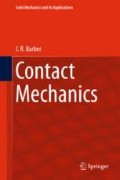Abstract
At very small length scales, the forces between molecules (e.g. van der Waals forces) become significant and must be taken into account in the solution of contact problems. These are most conveniently described by a scalar force potential V defined such that the force acting on a given molecule.
Access this chapter
Tax calculation will be finalised at checkout
Purchases are for personal use only
Notes
- 1.
We should not read too much into this result, since the molecules have been smeared out to generate continuous half-spaces.
- 2.
Here we have slightly modified Maugis’ original notation by omitting some numerical factors.
- 3.
We shall show in Sect. 12.4.1 that in practical cases, jump into contact generally occurs before we reach \(\varDelta \!=\!0\). The JKR theory therefore overestimates hysteresis losses.
- 4.
courtesy of J.A.Greenwood, private communication.
- 5.
Wu (2010) presents a similar comparison with apparently less good agreement, but this is a result of his confusing \(\varDelta \) with \((\varDelta \!-\!\varepsilon )\) [J. J. Wu, private communication].
- 6.
The perceptive reader will notice that this is identical to the result from the Hertz problem [Eq. (5.31)], and might [erroneously] deduce that Derjaguin et al. (1975) are correct in assuming the Hertz solution to apply in \(0\!\le \! r\!<\!a\). However, the contact pressure distribution is given by Eq. (12.84), and this will be influenced by the value of h(t) in \(t\!>\!a\) as well as in \(t\!<\!a\), even for points in \(0\!\le \! r\!<\!a\).
Author information
Authors and Affiliations
Corresponding author
Problems
Problems
1. Use the Lennard-Jones interatomic potential (12.2) to estimate the attractive force per unit area between two infinite layers each of finite thickness b. Hence determine the effective interface energy in separating two such layers from their equilibrium position for the case where \(b=3r_m\). Notice that the equilibrium position for finite layers differs from (12.9).
2. If we place two half-spaces at the equilibrium spacing of Eq. (12.9), the composite body essentially comprises a single stress-free monolithic body. Use this model with the force law (12.12) to obtain an estimate of Young’s modulus E as a function of \(\varDelta \gamma \) and \(\varepsilon \).
3. Two rigid bodies have quadratic profiles such that the initial gap function has the Hertzian form
Find the attractive force when they are at the point of closest approach and show that it reduces to Eq. (12.17) when \(R_x\!=\!R_y\).
4. A cylindrical rigid punch of radius a has a spherically concave end of radius R where \(R\!\gg \!a\). It is placed above a rigid half-space such that the separation on the axis \(r\!=\!0\) is h. Assuming the Lennard-Jones force law (12.12), find the attractive force F between the bodies as a function of h. For the special case where \(R=a^2/2\varepsilon \), find the value of h at which F is a maximum, and the value of this maximum [the pull-off force]. Why does this problem not fall into the category defined by Eq. (12.18), where the pull-off force is independent of the form of the force law?
5. A rigid sphere of radius R is compressed between two identical elastic half-spaces. The half-spaces are now gradually separated under displacement control. Use the JKR theory to describe the subsequent behaviour and define the relation between force and separation. Is this similar to Fig. 12.2? If not explain why not.
6. Use the JKR theory to find the pull-off force for the flat and rounded punch of Fig. 5.5.
7. Find the hysteretic energy loss implied by the contact-separation cycle illustrated in Fig. 12.3 for the JKR contact of a sphere on a plane, by evaluating the energy difference \(\varPi _A\!-\!\varPi _C\).
8. The atomic force microscope [AFM] in Fig. 12.10a can be idealized as an elastic body with a spherical tip of radius R supported on a spring of stiffness k, as shown in Fig. 12.10b.
The fixed end of the cantilever is moved down until the tip jumps into contact with an elastic plane. It is then moved up until the tip jumps out of contact. Use the JKR theory with composite modulus \({E^{*}}\) and interface energy \(\varDelta \gamma \) to determine the contact force just after jump-in and just before jump-out [this may require a numerical solution of the resulting equations]. Show that when k is small [the cantilever is very flexible], these force values are independent of k. How small does k need to be [in terms of \({E^{*}}, \varDelta \gamma , R\)] for the limiting values to provide good estimates.
9. A cylinder of radius R is pressed against a half-plane by a force P. Using the two-dimensional solutions from Chap. 6 and the stress intensity factor from Eq. (12.22), determine the relation between P and the contact semi-width a. Hence determine the pull-off force for this geometry. Does the pull-off force increase or decrease with \({E^{*}}\)?
10. Calculate the work done by the force P in the JKR solution in loading from point A to point C in Fig. 12.3 by evaluating the integral
Hence show that this is an alternative way of calculating the hysteresis loss of Problem 7.
11. A conical indenter with profile \(g_0(r)\!=\!\alpha r,\) \(\alpha \!\ll \!1\) is moved under displacement control towards an elastic half-space. Show (i) that a dimensionless parameter \(\lambda \) analogous to the Tabor parameter can be defined for this problem, and (ii) that if the force law is defined by (12.85), a universal dimensionless representation of the governing Eqs. (12.81), (12.83), (12.84) can be defined that is independent of \(\lambda \). Hence deduce an equation analogous to (12.89) showing how the approach \(\varDelta _\mathrm{{in}}\) at jump-in varies with \(\lambda \).
Rights and permissions
Copyright information
© 2018 Springer International Publishing AG
About this chapter
Cite this chapter
Barber, J.R. (2018). Adhesive Forces. In: Contact Mechanics. Solid Mechanics and Its Applications, vol 250. Springer, Cham. https://doi.org/10.1007/978-3-319-70939-0_12
Download citation
DOI: https://doi.org/10.1007/978-3-319-70939-0_12
Published:
Publisher Name: Springer, Cham
Print ISBN: 978-3-319-70938-3
Online ISBN: 978-3-319-70939-0
eBook Packages: EngineeringEngineering (R0)


